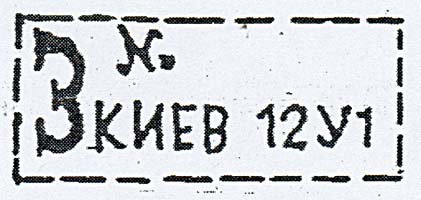Study Featuring 'Carpatho-Ukraine' Stamps and Mail
- Details
- Published on 11 March 2018
- Written by Mark Stelmacovich
- Hits: 16453
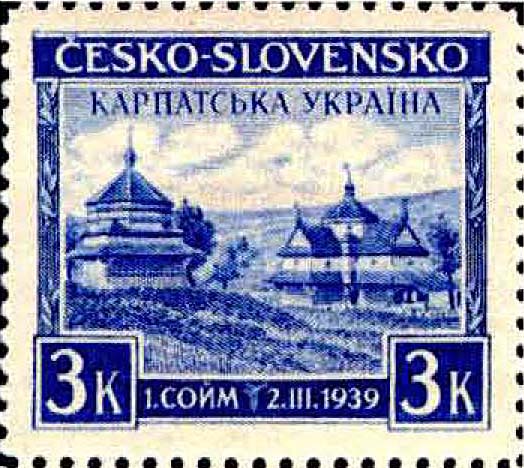 This study was initiated during 2013, and was circulated to society peers for vetting and feedback in October 2015. It elaborates on a genre of philately which is not as well-known as it should be. When Carpatho-Ukraine existed as a country, so very briefly in 1939 before being occupied by a neighbouring power, and then for most of 1945 before being absorbed into a neighbouring super-military, it produced stamps for 'its public'. These were a people who wanted their identity to be reflected in nationhood, though who had little choice but to bow to the dominance of others. Thus, and despite their locally produced stamps, some would argue that the nation of Carpatho-Ukraine was no more than a puppet of others, and so, not yet recognized by some philatelists who at the same time honour others with a similar history. It is a hope that this compilation will shed more light on the stamps that this small entity produced, and, as well, some of the history that these issues reflect. Know that there are many other Carpatho-Ukraine stamp texts, which this author learned from, that were completed by excellent members and friends of our UPNS!
This study was initiated during 2013, and was circulated to society peers for vetting and feedback in October 2015. It elaborates on a genre of philately which is not as well-known as it should be. When Carpatho-Ukraine existed as a country, so very briefly in 1939 before being occupied by a neighbouring power, and then for most of 1945 before being absorbed into a neighbouring super-military, it produced stamps for 'its public'. These were a people who wanted their identity to be reflected in nationhood, though who had little choice but to bow to the dominance of others. Thus, and despite their locally produced stamps, some would argue that the nation of Carpatho-Ukraine was no more than a puppet of others, and so, not yet recognized by some philatelists who at the same time honour others with a similar history. It is a hope that this compilation will shed more light on the stamps that this small entity produced, and, as well, some of the history that these issues reflect. Know that there are many other Carpatho-Ukraine stamp texts, which this author learned from, that were completed by excellent members and friends of our UPNS!
The First Postal (ZIP) Code in the World
- Details
- Published on 20 April 2009
- Written by Ingert Kuzych
- Hits: 31579
The use of mail sorting codes to expeditiously handle large volumes of mail is not a new idea. The first true postal codes date to the first half of the 20th century, and the first country to introduce them was Ukraine. 
Setting Up the Index
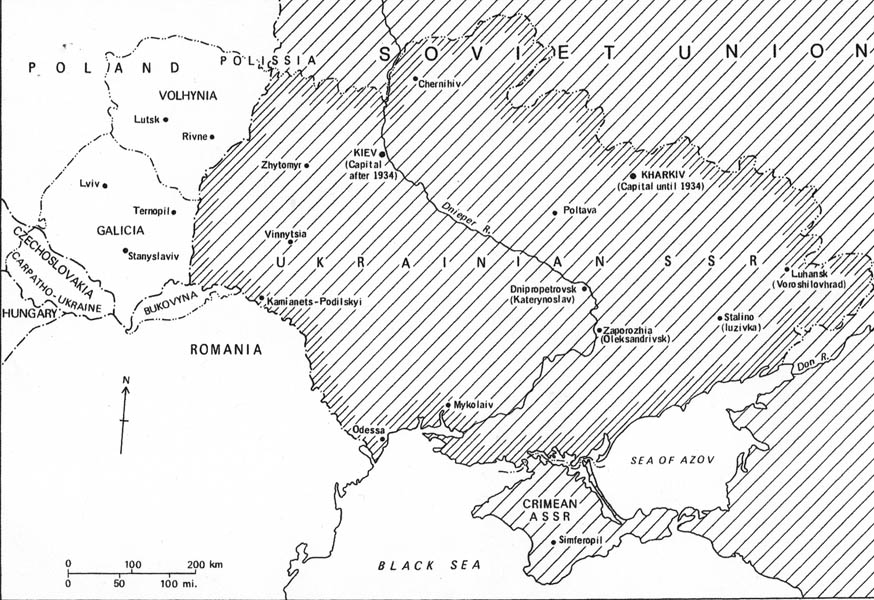 A sophisticated, three-part postal code system (described as an “Index”) was first introduced in December of 1932. This program was not a brief experimental venture limited to a small region of the country, but instead was a fully supported governmental effort that extended to all corners of interwar Ukraine (then part of the USSR) until abruptly discontinued in 1939. Four different Ukrainian-language informational postal cards, all printed in 1932, announced the new Index program. Although their texts differed, the messages were similar. The cards are described below.
A sophisticated, three-part postal code system (described as an “Index”) was first introduced in December of 1932. This program was not a brief experimental venture limited to a small region of the country, but instead was a fully supported governmental effort that extended to all corners of interwar Ukraine (then part of the USSR) until abruptly discontinued in 1939. Four different Ukrainian-language informational postal cards, all printed in 1932, announced the new Index program. Although their texts differed, the messages were similar. The cards are described below.
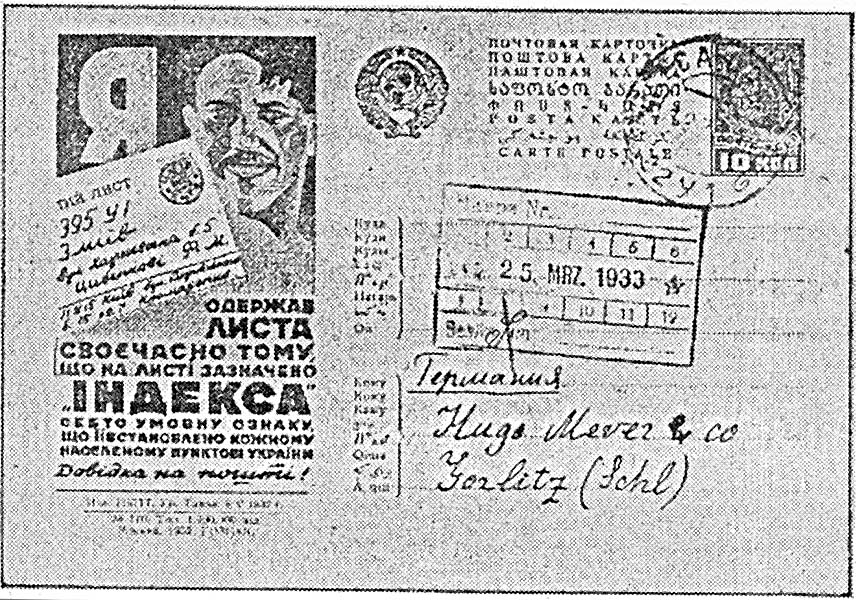 The 10-kopek, red postal card (no. 176) depicts a happy postal customer and a letter properly addressed with new postal codes. The text reads: “I received a letter quickly because the “Index” was indicated on the letter, that is, the conventional designation which was adopted by every populated area in Ukraine. Information at the post office!” Shown on the cachet mailing address is the Index 395 y 1 (for Zmiïv); the return address Index is 11 y 15 (in Kyiv).
The 10-kopek, red postal card (no. 176) depicts a happy postal customer and a letter properly addressed with new postal codes. The text reads: “I received a letter quickly because the “Index” was indicated on the letter, that is, the conventional designation which was adopted by every populated area in Ukraine. Information at the post office!” Shown on the cachet mailing address is the Index 395 y 1 (for Zmiïv); the return address Index is 11 y 15 (in Kyiv).
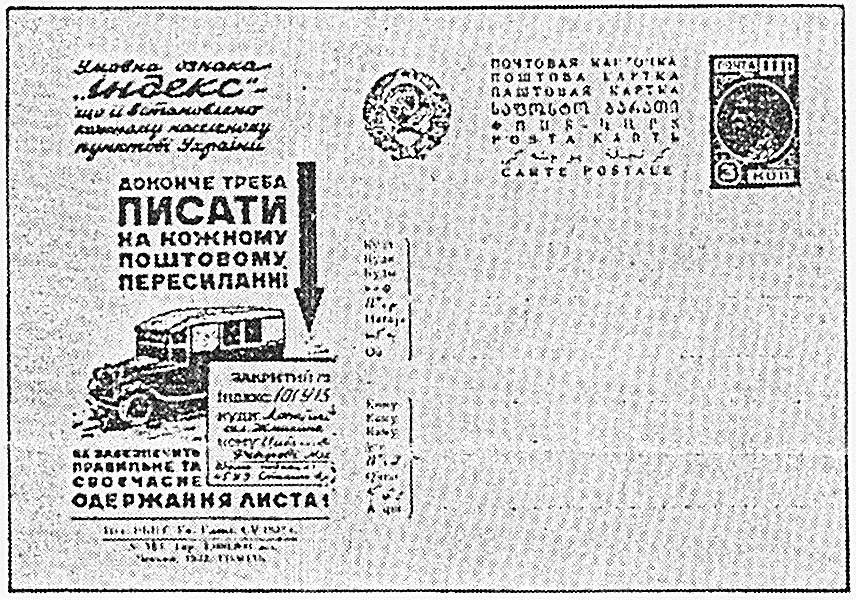 A 3-kopek, blue postal card (no. 184) shows a postal bus and the message: “The conventional designation “Index,” which was adopted by every populated area in Ukraine, is by all means required to be written on each postal dispatch. This ensures correct and timely receipt of a letter!”. The example Indexes on the depicted card next to the bus are 101 y 15 (for Budko Sobichins) and 45 y 3 (for Stalino).
A 3-kopek, blue postal card (no. 184) shows a postal bus and the message: “The conventional designation “Index,” which was adopted by every populated area in Ukraine, is by all means required to be written on each postal dispatch. This ensures correct and timely receipt of a letter!”. The example Indexes on the depicted card next to the bus are 101 y 15 (for Budko Sobichins) and 45 y 3 (for Stalino).
 The third item is also a 3-kopek, blue card (no. 185) and presents a mailman with a packet of letters. The text reads: “The correct address on a letter guarantees timely delivery! Inform all and write on the addresses the conventional indications “Index” – this is the correct way to address a letter! Information at the post office!”
The third item is also a 3-kopek, blue card (no. 185) and presents a mailman with a packet of letters. The text reads: “The correct address on a letter guarantees timely delivery! Inform all and write on the addresses the conventional indications “Index” – this is the correct way to address a letter! Information at the post office!”
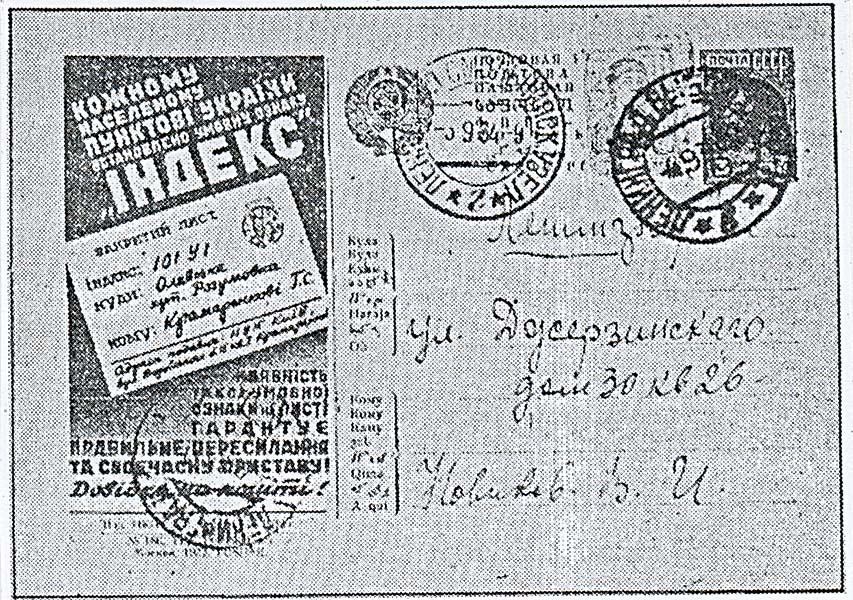 Finally, postal card no. 186, again 3-kopek and blue, displays an envelope with delivery and return addresses that each contain the new Index (for the cities of Olevsk and Kyiv, 101 y 1 and 11 y 15 respectively). The text reads: “A conventional indication “Index” has been assigned to every populated point in Ukraine. The presence of such a conventional designation on a letter guarantees correct sending and timely reception! Information at the post office!”
Finally, postal card no. 186, again 3-kopek and blue, displays an envelope with delivery and return addresses that each contain the new Index (for the cities of Olevsk and Kyiv, 101 y 1 and 11 y 15 respectively). The text reads: “A conventional indication “Index” has been assigned to every populated point in Ukraine. The presence of such a conventional designation on a letter guarantees correct sending and timely reception! Information at the post office!”
How the Index Worked
Every Index was composed of a number-letter-number series. The central Cyrillic ‘y’ (pronounced “oo”, as in boot) of an Index designation stood for (Y)KPAIHA (Ukraine) and so immediately identified mails destined for this republic of the Soviet Union. The first number (the fore-number) designated the importance and size of a location. Numbers 1 to 10 were assigned to the capital city of Kharkiv (1 through 7 allocated to major district (raion) postal centers in the city, but 8 to 10 held in reserve).
Remaining two-digit numbers indicated other major cities. So, 11 to 20 specified Kyiv (11 to 14 allocated, remainder in reserve), 21 to 29 Odesa (five numbers allocated), 30 to 33 Mykolaiv (only 30 allocated), 34 to 39 Dnipropetrovsk (four numbers allocated), 40 to 44 Zaporizhia (all five numbers allocated), 45 to 48 Stalino (presently Donetsk, four numbers allocated), 49 to 51 Mariupil (one number allocated), and so on to 89 to 91 for Kherson (one number allocated). Numbers 92 to 100 were kept in reserve.
Three-digit fore-numbers indicated raions of lesser importance in the country. So, 101 stood for the Oliev district (in Zhytomyr province) and this district was subdivided into 39 smaller postal drop off and pick up points, mostly village post offices. These raion subdivisions were indicated by the hind-numbers of the postal Index. The Oliev subdivisions, therefore, ranged from 101 y 1 to 101 y 39.
Raion subdivisions could vary tremendously in number, from 130 in Kharkiv raion to just nine in Staro Kermenchyk raion. Usually, though, they ranged between 20 and 40 in number. In all, 440 raions are enumerated in the Listing, while 46 large-city raion number slots were set aside for future use (i.e., the raion fore-numbers go as high as 486). Over 25,000 unique raion subdivision receiving points are specified.
Examples of Use Postal
Index codes more frequently appeared on the bottom halves of canceling devices, but they can also be found across the the tops and sometimes on the side.
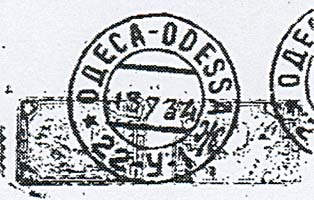
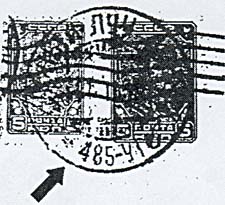
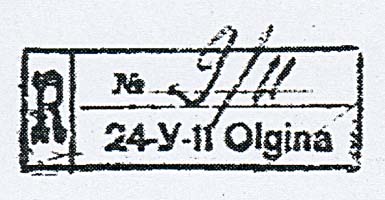
In addition, the codes are frequently seen on registration cachets, both those indicated with the Latin ‘R’ (for registered) or Russian Cyrillic ‘3’ (for zakaznoe).
The Fate of the Index System
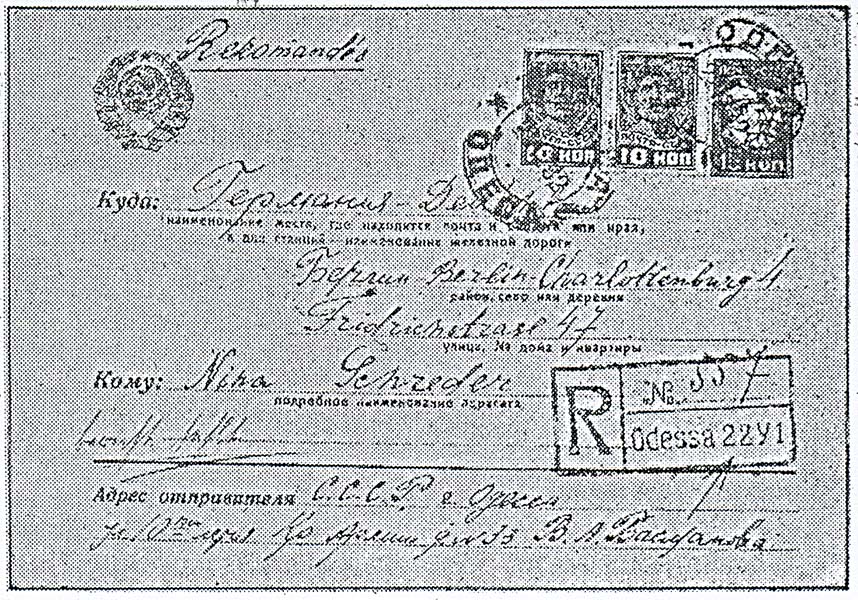 The Ukrainian Index system was suspended in the summer of 1939. The latest code described in the literature (22 y 1 from Odesa) dates to 25 June 1939 and the Index system most likely was discontinued at about this time. The abrupt cessation in use of the Index may have been for strategic reasons, since the rumblings and preparations for war increased as the year progressed. (The Nazi-Soviet Non-Aggression Pact, the so-called Molotov-Ribbentrop Agreement, was signed on 23 August 1939.) Postal codes were apparently not assigned to any locales in Western Ukraine, which came under Soviet occupation in September of 1939.
The Ukrainian Index system was suspended in the summer of 1939. The latest code described in the literature (22 y 1 from Odesa) dates to 25 June 1939 and the Index system most likely was discontinued at about this time. The abrupt cessation in use of the Index may have been for strategic reasons, since the rumblings and preparations for war increased as the year progressed. (The Nazi-Soviet Non-Aggression Pact, the so-called Molotov-Ribbentrop Agreement, was signed on 23 August 1939.) Postal codes were apparently not assigned to any locales in Western Ukraine, which came under Soviet occupation in September of 1939.
An alternate reason for the abandonment of the system may have been the stepped up purges of the latter 1930s. Newly installed Communist Party replacements may have wished to demonstrate their loyalty by eliminating the postal code, which perhaps by that time was seen as a manifestation of latent Ukrainian nationalism.
* * * * *
This article is expanded from a piece that first appeared in The Ukrainian Weekly Vol. 70 No. 5 (3 February 2002): 8.
The Ukrainian Underground Post
- Details
- Published on 19 January 2010
- Written by UPNS Admin
- Hits: 3439
The Ukrainian Underground Post
LITOPYS UPA Volume 47
Ukrainian, with English introduction
Toronto-Lviv 2009
Published by "Litopys UPA"
328 pages
color photographs
http://www.litopysupa.com/main.php?pg=2&bookid=278
The PPU, founded by Ukrainian émigrés in West Germany after the Second World War, operated under the aegis of the External Units of the Organization of Ukrainian Nationalists—the ZCh OUN(B)—from 1949 to 1983.
The founding family of Kyivan Rus'
- Details
- Published on 05 May 2010
- Written by Ingert Kuzych
- Hits: 18955
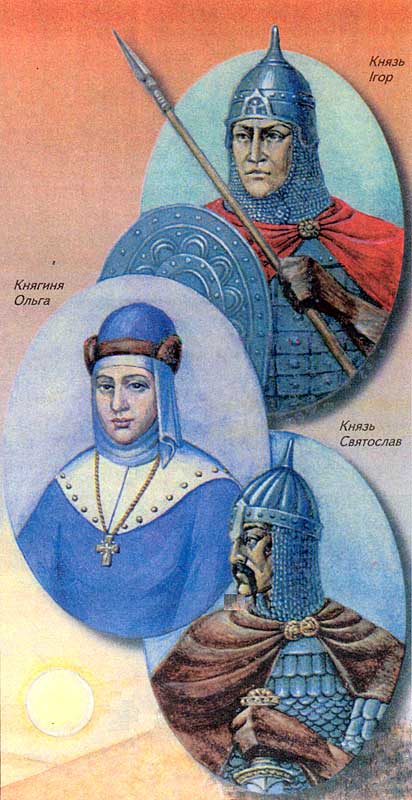 It has long frustrated me that so many historians, Ukrainian and otherwise, seem to accept so "blindly" the medieval records of early Kyivan Rus' (the first state on Ukrainian and eastern European lands). By "blindly" I mean that obvious inconsistencies within the earliest chronicles are parroted as if they were set in stone, without any critical examination and without searching for possible alternate sources. I have long had an interest in Ihor, my royal namesake of the
It has long frustrated me that so many historians, Ukrainian and otherwise, seem to accept so "blindly" the medieval records of early Kyivan Rus' (the first state on Ukrainian and eastern European lands). By "blindly" I mean that obvious inconsistencies within the earliest chronicles are parroted as if they were set in stone, without any critical examination and without searching for possible alternate sources. I have long had an interest in Ihor, my royal namesake of the
Trident Exhibit Put Up For Auction
- Details
- Published on 09 March 2010
- Written by UPNS Admin
- Hits: 8099
A Large Vermiel award winning Trident exhibit is up for grabs to the highest bidder. UPNS member David Crocker from South Africa has decided to part with his Trident exhibit which has been winning awards over the last 4 years. The oldest German stamp auction house, Heinrich Köhler, is offering the exhibit in auction 339/340 which runs March 22 - 27, 2010. The exhibit may be viewed in the Exhibit section of this site.
The Rus' Coin Scandal
- Details
- Published on 06 September 2013
- Written by Jerry Kalyn
- Hits: 7901
An article in the Journal "Museums of Ukraine" appeared February 9th this year bringing into question the legality of a Moscow auction featuring rare Kyivan Rus' sribnyk coins and hryvnia bars. Coins were minted in Rus from the first half of the 11th century on into the 1st quarter of the next century. During the reign of Grand Prince Volodymyr the Great (Old East Slavic: Володимѣръ Свѧтославичь, Old Norse: Valdamarr Sveinaldsson) gold and silver coins were minted, modeled on contemporary Byzantine currency of that time.
Ukraine wins Coin of the Year at COINS-2010
- Details
- Published on 17 June 2010
- Written by UPNS Admin
- Hits: 17969
A total of 209 coins from 24 countries were submitted for the competition and


